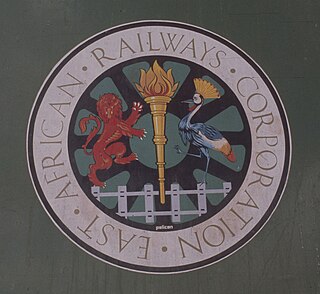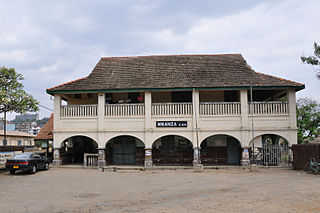Related Research Articles

Frederick John Dealtry Lugard, 1st Baron Lugard, known as Sir Frederick Lugard between 1901 and 1928, was a British soldier, mercenary, explorer of Africa and a colonial administrator. He was Governor of Hong Kong (1907–1912), the last Governor of Southern Nigeria Protectorate (1912–1914), the first High Commissioner (1900–1906) and last Governor (1912–1914) of Northern Nigeria Protectorate and the first Governor-General of Nigeria (1914–1919).

Lake Albert, originally known as Lake Mwitanzige and temporarily Lake Mobutu Sese Seko, is a lake located in Uganda and the Democratic Republic of the Congo. It is Africa's seventh-largest lake, as well as the second biggest of Uganda's Great Lakes.

The Uganda Railway was a metre-gauge railway system and former British state-owned railway company. The line linked the interiors of Uganda and Kenya with the Indian Ocean port of Mombasa in Kenya. After a series of mergers and splits, the line is now in the hands of the Kenya Railways Corporation and the Uganda Railways Corporation.
Tsavo East National Park is a national park in Kenya with an area of 13,747 km2 (5,308 sq mi). It was established in April 1948 and covers a semi-arid area previously known as the Taru Desert. Together with the Tsavo West National Park, it forms an area of about 22,000 square kilometers. The Tsavo River flows west to east through the national park, which is located in the Taita-Taveta County of the former Coast Province.

Lake Victoria ferries are motor ships for ferry services carrying freight and/or vehicles and/or passengers between Uganda, Tanzania, and Kenya on Lake Victoria.

The Imperial British East Africa Company (IBEAC) was a commercial association founded to develop African trade in the areas controlled by the British Empire. The company was incorporated in London on 18 April 1888 and granted a royal charter by Queen Victoria on 6 September 1888. It was led by William Mackinnon and built upon his company's trading activities in the region, with the encouragement of the British government through the granting of an imperial charter, although it remained unclear what that actually meant.

The East African Railways and Harbours Corporation (EAR&H) is a defunct company that operated railways and harbours in East Africa from 1948 to 1977. It was formed in 1948 for the new East African High Commission by merging the Kenya and Uganda Railways and Harbours with the Tanganyika Railway of the Tanganyika Territory. As well as running railways and harbours in the three territories it ran inland shipping services on Lake Victoria, Lake Kyoga, Lake Albert, the Victoria Nile and the Albert Nile.
Lugard may refer to:
Fleming and Ferguson was a Scottish marine engineering and shipbuilding company that traded between 1877 and 1969.
Dagoretti is an area in the western part of Nairobi, the capital of Kenya. It straddles the Nairobi and Kiambu County boundary with the Dagoretti Road Reserve marking the psychological border point heading Northerly and North-Easterly. Administratively it is one of eight divisions of Nairobi. The Dagoretti division is divided into six Locations. The former electoral Dagoretti Constituency had the same boundaries as the now defuct Dagoretti division.

MV Victoria is a Lake Victoria ferry operated by the Marine Services Company Limited of Tanzania.

SS Nyanza is a disused passenger-cargo steamer on Lake Victoria in East Africa. She is one of seven Clyde-built ships called Nyanza that were launched between 1867 and 1956.
SS Rusinga is a cargo and passenger Lake Victoria ferry in East Africa.
SS Winifred was a cargo and passenger Lake Victoria ferry in East Africa.

SS Robert Coryndon was a British twin-screw passenger and cargo ferry on Lake Albert in central Africa.
PS Lugard II was a British passenger ferry in Uganda. She was a side wheel paddle steamer with a shallow draught in order to operate on the Victoria Nile and Albert Nile. She was named after Frederick Lugard, 1st Baron Lugard, who late in the previous century had explored Uganda, secured much of it for the British Empire and served as its Military Administrator 1890–92.
PS Speke was a British stern wheel paddle steamer in Uganda. She was built for the Uganda Railway in 1910 to operate on Lake Kyoga and the Victoria Nile. First and second class passengers travelled aboard the steamer but she also pushed a barge or lighter on which cargo and third class passengers travelled.

The history of rail transport in Tanzania began in the late nineteenth century.
The East Africa High Commission (EAHC) was an international organisation which existed between 1 January 1948 and 9 December 1961 with the intention of providing common services to the British-administered Uganda, Kenya and Tanganyika. It superseded the East Africa Governors' Conference and was later replaced by the East African Common Services Organization (EACSO). The EACSO in turn was replaced by the first East African Community in 1967.

George Wilson CB also known as bwana tayari - "Mr. Ready", amongst natives in East Africa, was a general African staff employee of the Imperial British East African company (1890–1891). He served as Chief Lieutenant to then-Captain Sir Frederick D. Lugard from 1889 to 1890, and was second in command during Lugard's caravan expedition to Uganda on 6 August 1890. The Europeans were Fenwick De Winton, William Grant, and Archibald Brown. Wilson joined the Uganda Service/government in 1894 and his first order of business was establishing a 'native baraza' or council that was structured as a native administration, with himself as the chief administrative officer who presided over all matters involving the government in conjunction with the Kabaka and later on he was in civil charge of the Protectorate during the outbreak of the Sudanese mutiny. He was appointed first class transport officer then the 1st class assistant of the Uganda protectorate on 30 August 1894. Was the sub-commissioner of the Buganda Kingdom in 1895. Also Was Her Britannic Majesty's acting commissioner and the commander in chief of the Uganda Protectorate and the consul-general. Was awarded the C.B. on 2 January 1899. He was the first ever Chief collector for the Bunyoro district. He was tasked with drawing up the 1901 Ankole agreement and presenting it to the Ankole chiefs and the Ankole people before it was signed in August of that year with the blessing of Ankole, the colonial administration and the UK government in Whitehall with Wilson as the protectorate's Chief negotiator and representative. Mr. Wilson was then the deputy commissioner of the Uganda Protectorate at Entebbe, government house and deputy governor of the protectorate. He was H.M. – His Majesty's commander in chief and acting commissioner of the Uganda protectorate (1904–1906) and. Was a fellow at the Royal Society of Arts and a silver medal recipient since 28 June 1907.
References
- ↑ "History". Kenya Railways. Retrieved 2022-10-14.
- ↑ "Behold, a Dream Unfulfilled". Ugandan Insomniac; Want to sleep, can't sleep. WordPress. 2009-03-25. Retrieved 2011-05-18.
- ↑ Cameron, Stuart; Allan, Bruce. "PS Lugard II". Clyde-built Database. Archived from the original on 2012-07-17. Retrieved 2011-05-22.
{{cite web}}: CS1 maint: unfit URL (link)